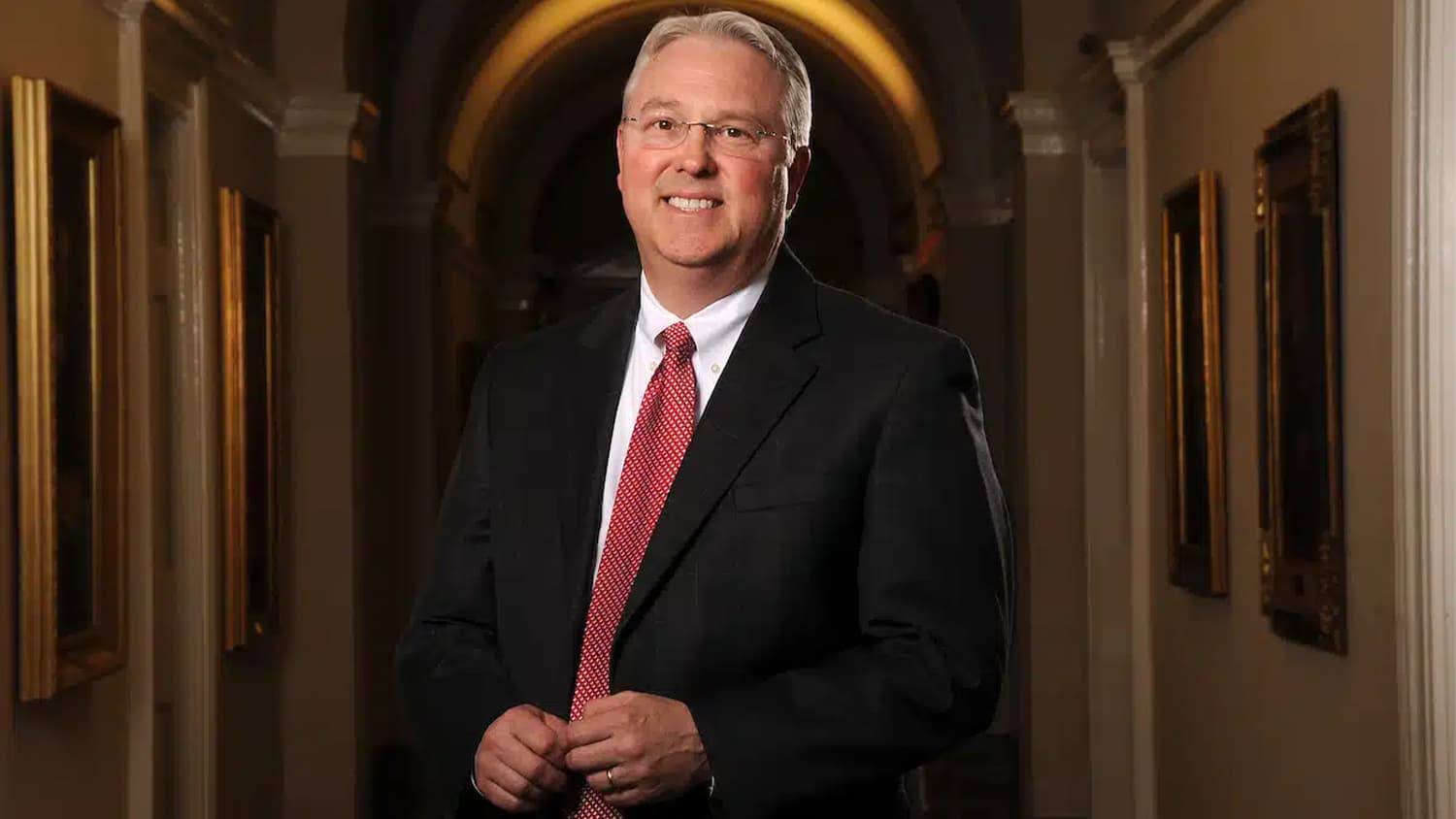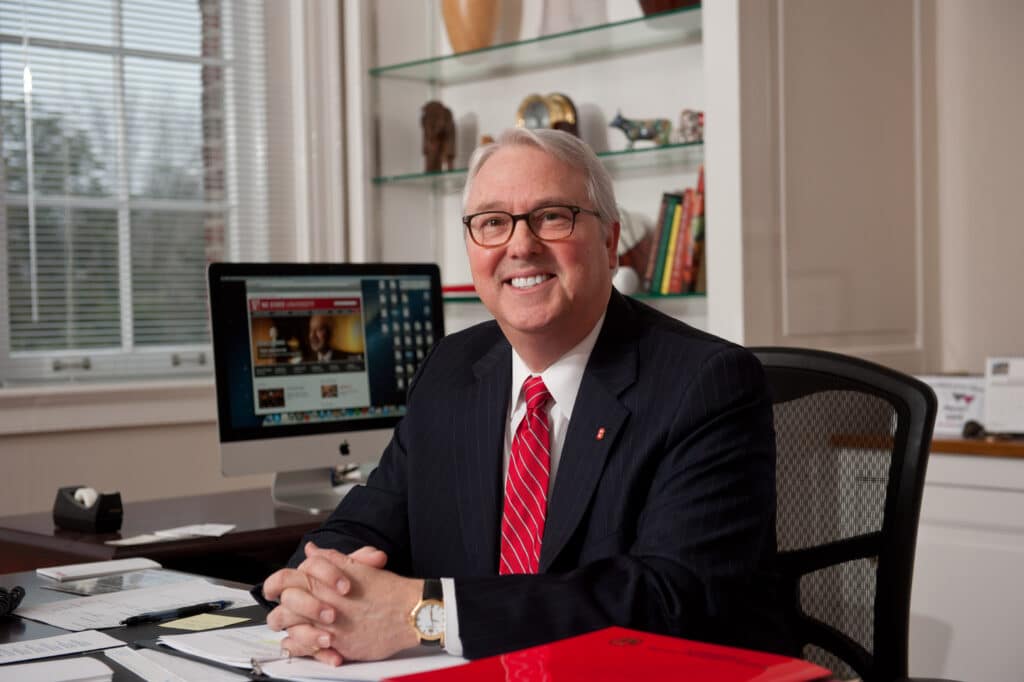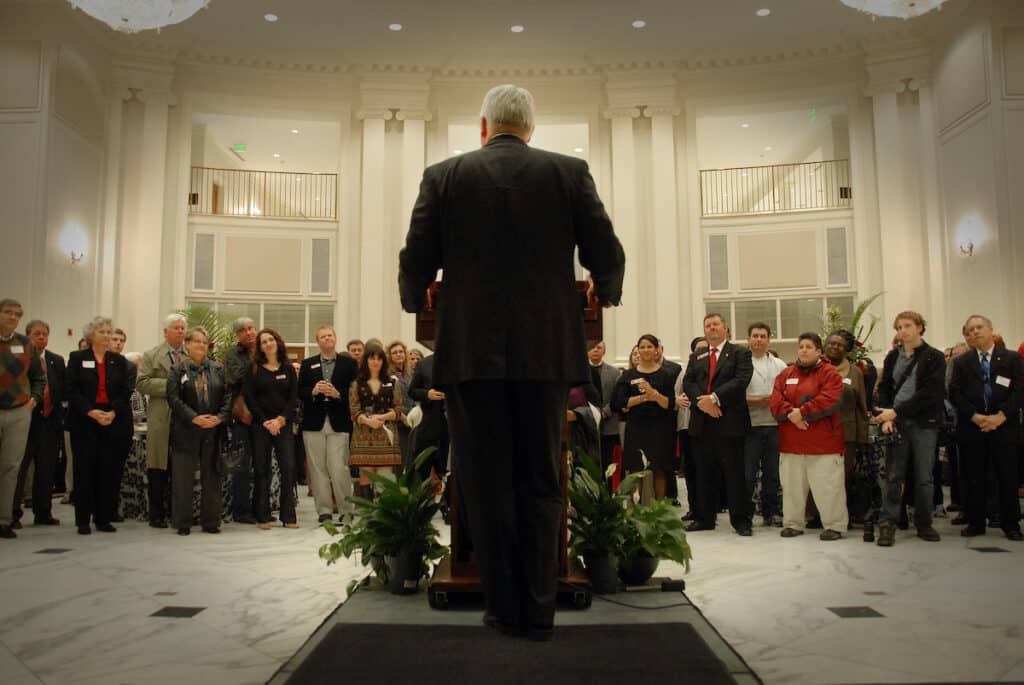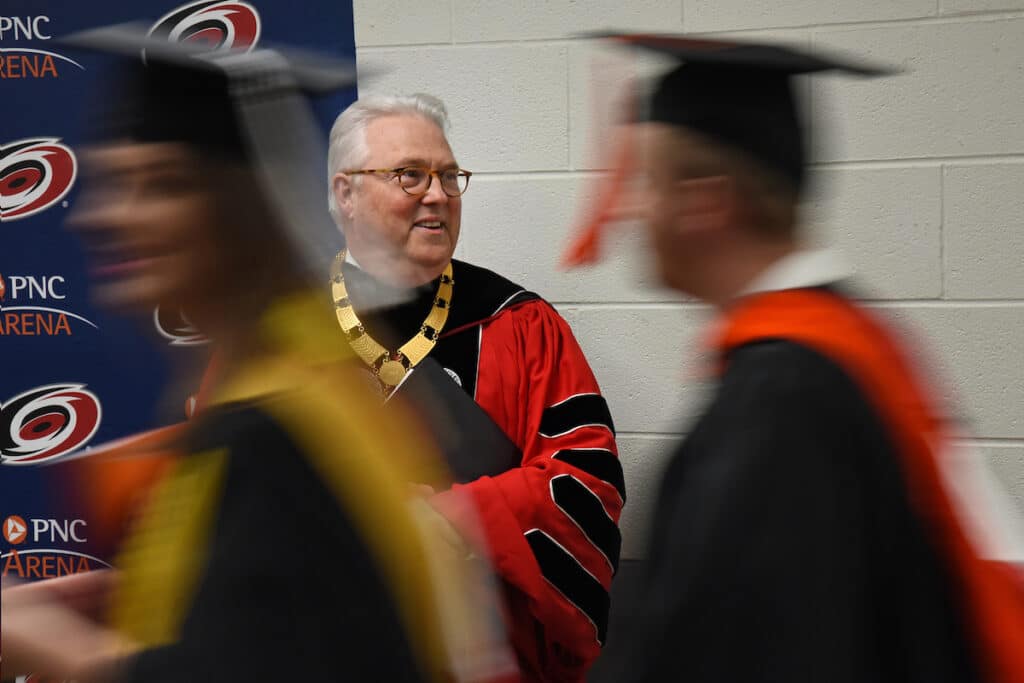A Chancellor’s First Day
Randy Woodson’s first day in Holladay Hall kicked off a 14-year tenure of change and advancement at a historic land-grant institution that was fraying around the edges. As he prepares to retire, here’s a look back at what campus was like when he took over.

Editor’s note: Chancellor Randy Woodson has announced he will retire on June 30, 2025. This article is part of the Celebrating Transformation initiative, a yearlong effort to honor the chancellor’s 14 years of service and to recognize the university’s extraordinary achievements under his leadership. Learn more and join the celebration at https://transformation.ncsu.edu/.
On his first day on the job as NC State’s 14th chief executive officer, April 5, 2010, Randy Woodson was sent home for an unspoken dress-code violation.
Cut-off jeans? Muscle shirt? Booty shorts?
No, the new leader walked into Holladay Hall from the school-provided chancellor’s residence (now the Gregg Museum of Art & Design) wearing a brand-new tailored suit, a red power tie and a freshly starched shirt.
A light blue shirt.
P.J. Teal, then secretary of the university, had scheduled several critical first-impression meetings that day for her new boss, including a breakfast meeting with student government leaders at Clark Dining Hall and lunch with former Raleigh mayor Smedes York (’62) at the Player’s Retreat, a Hillsborough Street watering hole and restaurant where the chancellor and York have met every year on the anniversary of Woodson’s first day.
She took one look at Woodson’s first-day-of-school outfit and told him to go home and find a shirt of any other color.
“P.J., I only have white shirts and blue shirts,” the chancellor told her.
“Well, go put on a white one and get rid of all the blue ones,” she said. “And drive your car over here and park it in space No. 1 so people will know you are working today.”
Both were important introductory lessons for the former provost at Purdue University, a peer land-grant institution, and he has never forgotten them. To this day, there’s nary a light blue shirt in his closet, just one of a million changes he’s made during nearly 15 years as the leader of the largest school in the University of North Carolina System.
He’s not the only one that’s changed during that time. NC State is not the same campus it was on Woodson’s first day, in many ways because of the improvements and upgrades he has championed since he first swapped shirts and got to work.

Woodson inherited a campus that was still growing from a 2002 bond issuance by the North Carolina General Assembly, but weakened by the instability of having four different leaders — two permanent chancellors and two interims — in the previous seven years.
Campus wasn’t exactly in shambles, though there was construction on just about every corner. It was, however, fraying around the edges. When Woodson came back from his breakfast inaugural meeting with student leaders, there was a lost dog barking and scratching on a door in Holladay’s chancellor suite.
“Is everybody in there OK?” Woodson asked his communications specialist, who had given safe harbor to a lost pet Teal had rescued on her way back from taking the chancellor to breakfast.
Let’s just say no one really knew how to behave just yet around the chancellor back then, though he seemed perfectly pleasant when he was first introduced at a Jan. 8 reception at the Park Alumni Center. They didn’t know if he would be intense like Marye Anne Fox, more visible than six-month interim Robert A. Barnhardt, more formal like James Oblinger or a little more laid back like one-year interim James Woodward — the leaders who had guided NC State into the new millennium.
“It was really a crazy time in the history of the university,” says Jim Ceresnak (Political Science ’10) of Charlotte, who served as NC State’s student body president during Woodward’s interim tenure and was a member of Woodson’s hiring committee.
The committee knew it would take a unique leader to tie together the hurdles NC State needed to jump in a down economy, with a belt-tightening legislature and a slew of potholes above and beyond the ones on torn-up Hillsborough Street.
With his background and roots, as a Southern guy who plays bluegrass guitar, and his academic background in agricultural research, it was pretty clear he was the perfect fit to be the next chancellor.
“There was an interesting suite of candidates and they all had their strengths,” says Ceresnak, now a commercial real estate broker in his hometown after 10 years on Wall Street. “All of them would have been great as heads of universities, but not necessarily NC State University.
“With his background and roots, as a Southern guy who plays bluegrass guitar, and his academic background in agricultural research, it was pretty clear he was the perfect fit to be the next chancellor. It’s pretty cool to be here 15 years later and talking about what he has done for the university.”
Perhaps the two overriding legacies of Woodson’s time at NC State are the stability he brought to campus and his longevity of service. Among NC State’s 14 chief executive officers, only Col. John C. Harrelson and John T. Caldwell served longer than Woodson.
A Changing — and Improving — Campus
On Woodson’s second day in the office, college ratings website Campus Squeeze declared NC State the seventh-ugliest campus in the country. It was hardly the kind of Top 10 ranking the university has chased since Woodson’s arrival.
Technician’s editorial board surmised that “It’s not as bad as it looks,” but admitted that constant construction diminished campus aesthetics. Campus sectors were poorly defined and not at all welcoming. Branding was limited, both physically and in reputation: “Think and Do” had not yet been thought, much less done.

Talley Student Center was really no different from the student center that opened in 1972. Woodson was fully behind the renovation and upgrades to what eventually became the Talley Student Union.
Harrelson Hall was still standing on pillars on University Plaza. Pullen Park was closed for a year-long upgrade. Everything was a bit of a mess.
So much of what now seems like long-standing parts of campus were nonexistent or in the early planning stages. Centennial Campus’s Oval was a half-completed Ov, not yet encircled by Hunt Library, Fitts-Woolard Hall and Wolf Ridge. The North Carolina Plant Sciences Initiative was just a concept, and the Integrative Sciences Building had no place to be built.
Just as dire, from Woodson’s point of view, was the university’s financial state. The UNC System had just cut 1,000 jobs from its 17 institutions and was mulling the elimination of 1,000 more. The trickledown from the 2008 economic meltdown had major impacts on a campus population that, at the time, included 27,000 undergraduates and 8,000 faculty and staff.
On the day he was installed as chancellor, he told a heavily sweating audience in blazing Reynolds Coliseum that the university had to increase its federal research funding and its private donations to the endowment. At the time, NC State had about $139 million annually in federal research expenditures; in 2022, the most recent numbers available, that total has increased to $251 million.
“We are not going to let budget challenges cripple us, but we have to move forward knowing that we have to think differently about our operations,” Woodson said that afternoon.
At the time, the university endowment was roughly $400 million. Since then, following a $2.1 billion campaign, six annual Days of Giving and the increase in federal research funding, NC State has nearly quintupled the size of its endowment, which was recently updated to $2.22 billion for 2024.
And the 75-year-old coliseum now has air conditioning.

A Collaborative Endeavor
Many have had a hand in fulfilling Woodson’s vision from his inaugural days. Deans in every college have turned over during Woodson’s tenure, some multiple times, which is more of a testament to his longevity than a knock on stability. Then-interim provost Warwick Arden, whom Woodson hired on a permanent basis in late 2010, has been part of the process throughout.
In athletics, Lee Fowler was the athletics director, Sidney Lowe was the men’s basketball coach, Kellie Harper was the women’s coach and Tom O’Brien was the football coach. Baseball coach Elliott Avent, men’s track and field and cross-country coach Rollie Geiger and director of track programs Laurie Henes are the only head coaches who remain from then.
Woodson’s first hire was Alumni Association executive director Benny Suggs, a retired U.S. Navy rear admiral who left an executive position at Harley-Davidson in Wisconsin to return to NC State. The association was in a financial crisis that Suggs helped stabilize in a dozen years on the job.
Three weeks into his tenure, Woodson revealed some of his vision for the future in the final student senate meeting of the school year, putting them at the top of his list for attention, followed closely by increasing the university’s visibility.
“I’ll be available and accessible to students,” he said to the student leadership audience that included newly elected president Kelly Hooks. “The only reason I do this is to support the students. I’ve got to make an effort to go out and engage with students.”
Woodson is well-known to students, especially on move-in days and the rest of Wolfpack Welcome Week in the heat of August.
He also put an immediate emphasis on improving the school’s branding and reputation.
“This is a strong university but I think that’s a well-kept secret,” he told the student senate. “[NC State] has always been a very modest and practical university. We’ve got to be more boastful and tell the story of the university a little better. I want to make sure the value of your diploma goes up.”
Finally, he had some ideas about knocking down silos on campus, making sure the 10 colleges worked together in solving big problems, particularly through innovative educational ideas like the Chancellor’s Faculty Excellence Program, an initiative that hires faculty to work in interdisciplinary clusters.
“Every university has a level of decentralization and you do want that,” Woodson said. “We’ve got to figure out how to create interdisciplinary programs for the students.”
He made some structural changes to the university, migrating all of the original departments in the College of Physical and Mathematical Sciences and some of the faculty, students, staff and degree programs in the College of Agriculture and Life Sciences to form the new College of Sciences.
Getting to Work
For the first few weeks — after the lost dog was reunited with its owner — Woodson’s office was relatively quiet. He had a standing 8 a.m. daily meeting with staff, listening to a straightforward list of everything that needed to be done that day. It was kind of a breeze.
After about a month, when he had initiated meetings with necessary campus leaders, he came in and took charge.
“I’m going to initiate an athletics director search, a provost search and launch a universitywide strategic plan,” he announced.
“All at once?” Teal asked him.
“We have to,” Woodson said.
“The pace increased dramatically after that,” Teal said.
Woodson has barely slowed down since.
- Categories:


